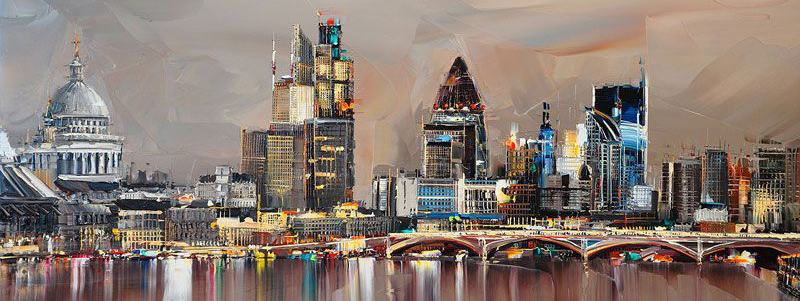Greenwich - To Greenwich by boat - The Cutty Sark an Gipsy Mouth IV - Blakheath - Charlton - Woolwich - Plumstead - Eltham
 The buildings in Greenwich exhibit a wide variety of architectural styles and are almost an anthology of styles. Among the most beautiful and well-known is the Greenwich Hospital on River Road. When King William decided to transform Hampton Court into a royal residence in 1694, Wren was asked to complete the buildings in Greenwich to make them a military hospital and home for naval officers. However, as early as 1428, Humphrey, Duke of Gloucester and brother of Henry V, had built a palace here called Bella Court, which a century later was rebuilt and called Placentia. Within its walls, Henry VIII was born and had married both Catherine of Aragon and Anne of Cleves. When James I had given Greenwich to his wife, Queen Anne of Denmark, she had asked Inigo Jones to build another palace for her opposite Placentia. The two homes were to be joined by a bridge traversing Dover Road. The construction of the palace, the Queen's House, built in the Palladian style, began in 1616. By 1635, the building was complete, but in the meantime the queen had died. Henrietta Maria, the French wife of King Charles I, lived in the house, and called it "her delight," and there she returned as a widow after the tragedy of the civil war. The house was later demolished and rebuilt with a different floor plan. The paintings by Orazio Gentileschi, which once covered the ceiling, were moved to Marlborough House.
The buildings in Greenwich exhibit a wide variety of architectural styles and are almost an anthology of styles. Among the most beautiful and well-known is the Greenwich Hospital on River Road. When King William decided to transform Hampton Court into a royal residence in 1694, Wren was asked to complete the buildings in Greenwich to make them a military hospital and home for naval officers. However, as early as 1428, Humphrey, Duke of Gloucester and brother of Henry V, had built a palace here called Bella Court, which a century later was rebuilt and called Placentia. Within its walls, Henry VIII was born and had married both Catherine of Aragon and Anne of Cleves. When James I had given Greenwich to his wife, Queen Anne of Denmark, she had asked Inigo Jones to build another palace for her opposite Placentia. The two homes were to be joined by a bridge traversing Dover Road. The construction of the palace, the Queen's House, built in the Palladian style, began in 1616. By 1635, the building was complete, but in the meantime the queen had died. Henrietta Maria, the French wife of King Charles I, lived in the house, and called it "her delight," and there she returned as a widow after the tragedy of the civil war. The house was later demolished and rebuilt with a different floor plan. The paintings by Orazio Gentileschi, which once covered the ceiling, were moved to Marlborough House.The King William Building on the eponymous street, consisting of four buildings with two domes designed by Wren, is also a landmark of seventeenth and eighteenth-century architecture. But these are just two examples of the many remarkable buildings found here. As an example, at number 90 Mycenae Road, stands the charming Woodlands House, built in 1774 by George Gibson as a country residence for John Julius Angerstein, a marine insurer, whose art collection formed the nucleus of the National Gallery. The house now hosts an art gallery.
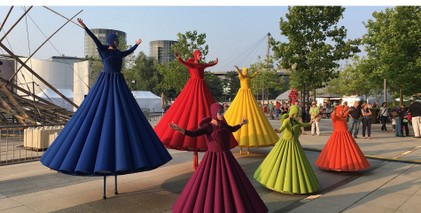 In mid-June, for four days, an eccentric and bizarre multicultural festival takes place, namely the Greenwich and Docklands International Festival. It takes place in various locations, including the O2 Arena, Cutty Sark Gardens, and the Royal Observatory. There are tango demonstrations, acrobatic dances from Southeast Asia, and music from all over Europe.
In mid-June, for four days, an eccentric and bizarre multicultural festival takes place, namely the Greenwich and Docklands International Festival. It takes place in various locations, including the O2 Arena, Cutty Sark Gardens, and the Royal Observatory. There are tango demonstrations, acrobatic dances from Southeast Asia, and music from all over Europe.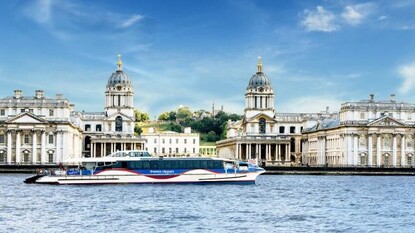 The best way to reach this place of rare beauty, located southeast of the City and north of Roman Watling Street, is by boat. On beautiful spring or summer days, the group of buildings that line the nine miles of shore can be appreciated in their entirety, whilst aboard one of the boats that depart from Westminster, Charing Cross or Tower Pier. It is equally enjoyable to allow one’s gaze to wander up the hill, with Flamsteed House closing the view of the southern slope and the area that has been elected World Heritage Site.
The best way to reach this place of rare beauty, located southeast of the City and north of Roman Watling Street, is by boat. On beautiful spring or summer days, the group of buildings that line the nine miles of shore can be appreciated in their entirety, whilst aboard one of the boats that depart from Westminster, Charing Cross or Tower Pier. It is equally enjoyable to allow one’s gaze to wander up the hill, with Flamsteed House closing the view of the southern slope and the area that has been elected World Heritage Site.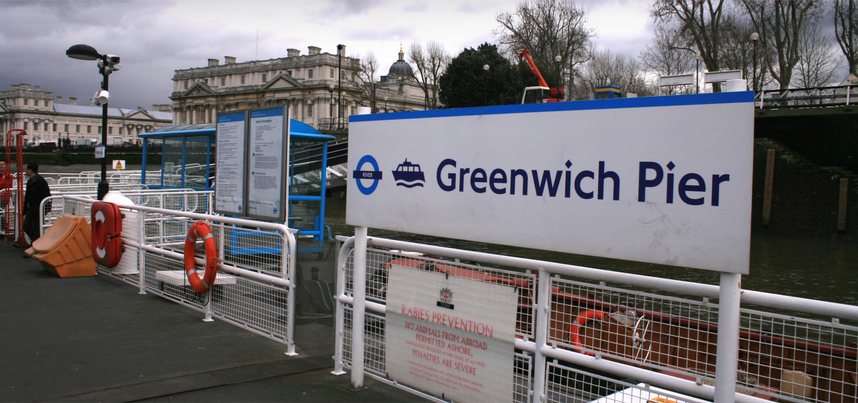
Greenwich Pier is an important stop for several companies that provide service on the Thames. Here, we find a stop off for the "commuter catamaran", run by the Thames Clipper company, which departs from Embankment and, via Tower Millennium Pier, Canary Wharf and Woolwich Arsenal Pier, reaches Greenwich. There is also a tourist service that departs from Westminster, stops at Waterloo, and finally at the Tower, stopping near museums, parks and even the Royal Observatory.
...OR THROUGH THE TUNNEL
TRAIN: GREENWICH
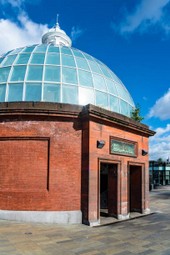 If you don't want to travel on the river, one can admire a beautiful view of Greenwich from Island Gardens, a small oasis of green on the north bank of the river. After this, one can take the pedestrian tunnel under the river, its entrance marked by two terracotta temples, one on each side. Emerging on the other side, one can walk along the shore and through the centre, which has remained intact.
If you don't want to travel on the river, one can admire a beautiful view of Greenwich from Island Gardens, a small oasis of green on the north bank of the river. After this, one can take the pedestrian tunnel under the river, its entrance marked by two terracotta temples, one on each side. Emerging on the other side, one can walk along the shore and through the centre, which has remained intact.The news of the opening of the Greenwich Foot Tunnel, which occurred in 1902, was given by the Illustrated London News. The newspaper had published pictures of Londoners flocking to walk through this new wonder beneath the Thames, the work of Alexander Binnie. Inside the small round brick pagodas, shaped like domes, where the entrance is located, there is also a mahogany-clad elevator that takes you to the tunnel. 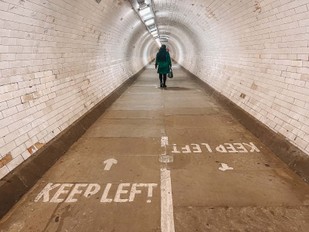 It is three hundred and seventy meters long, three meters wide, and covered with two hundred thousand glossy white tiles. When the tide is high, its depth at the central point is of about sixteen meters. The northern entrance is in the Island Gardens of the Isle of Dogs, while the southern one is in the Cutty Sark Gardens of Greenwich. As an alternative to the lift, which is closed at night, there is also a spiral staircase. Watch out for cyclists!
It is three hundred and seventy meters long, three meters wide, and covered with two hundred thousand glossy white tiles. When the tide is high, its depth at the central point is of about sixteen meters. The northern entrance is in the Island Gardens of the Isle of Dogs, while the southern one is in the Cutty Sark Gardens of Greenwich. As an alternative to the lift, which is closed at night, there is also a spiral staircase. Watch out for cyclists!
 It is three hundred and seventy meters long, three meters wide, and covered with two hundred thousand glossy white tiles. When the tide is high, its depth at the central point is of about sixteen meters. The northern entrance is in the Island Gardens of the Isle of Dogs, while the southern one is in the Cutty Sark Gardens of Greenwich. As an alternative to the lift, which is closed at night, there is also a spiral staircase. Watch out for cyclists!
It is three hundred and seventy meters long, three meters wide, and covered with two hundred thousand glossy white tiles. When the tide is high, its depth at the central point is of about sixteen meters. The northern entrance is in the Island Gardens of the Isle of Dogs, while the southern one is in the Cutty Sark Gardens of Greenwich. As an alternative to the lift, which is closed at night, there is also a spiral staircase. Watch out for cyclists!Two ships capture the attention of pedestrians emerging from the tunnel onto the windy square as well as those disembarking from boats arriving from Westminster: the Cutty Sark and Francis Chichester's Gipsy Moth IV.
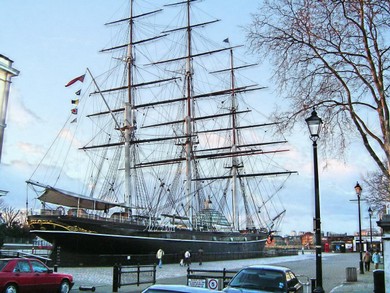 The Cutty Sark, whose name comes from an archaic Scottish expression for “short nightdress” taken from Burns' poem Tam O'Shanter, was built in 1863 by Scott and Linton. It is a clipper, a large and fast sailing ship - extremely fast in fact under Captain Woodget - which in the nineteenth century sailed the oceans to bring Europe tea from China and wool from Australia.. In 1922, Captain Dowman purchased it, refitted it, and anchored it in Falmouth. In 1949, he offered it as a gift to the National Maritime Museum. It was the last clipper left. Walking on the deck, one is impressed by the ten miles of coiled and intricate ropes that form the rigging. Underneath, one can see the compartments where wool bales were once stored. The exhibited images allow you to see the different phases of construction and launching. There is also a collection of stern decorations, which adorned the sterns of ships in the nineteenth century. On May 21, 2007, the boat caught fire but was later restored.
The Cutty Sark, whose name comes from an archaic Scottish expression for “short nightdress” taken from Burns' poem Tam O'Shanter, was built in 1863 by Scott and Linton. It is a clipper, a large and fast sailing ship - extremely fast in fact under Captain Woodget - which in the nineteenth century sailed the oceans to bring Europe tea from China and wool from Australia.. In 1922, Captain Dowman purchased it, refitted it, and anchored it in Falmouth. In 1949, he offered it as a gift to the National Maritime Museum. It was the last clipper left. Walking on the deck, one is impressed by the ten miles of coiled and intricate ropes that form the rigging. Underneath, one can see the compartments where wool bales were once stored. The exhibited images allow you to see the different phases of construction and launching. There is also a collection of stern decorations, which adorned the sterns of ships in the nineteenth century. On May 21, 2007, the boat caught fire but was later restored.The Gipsy Moth IV is the famous ketch with which Francis Chichester set out on his solo journey around the world in 1966-67. He had it built specifically for this purpose and so that it could be piloted by one person. It was equipped with the maximum possible sail area for the minimum possible amount of rigging. The Gipsy Moth started the crossing in March 1967 and arrived in Sydney one hundred and seven days later. This stop was made because the boat had been damaged by the waves and needed repairs. Including this delay, the journey lasted two hundred and seventy-four days, with two hundred and twenty-six days of actual sailing. In 2006, it was restored to repeat the journey on the occasion of the anniversary of the previous one.
ST ALPHEGE CHURCH
HIGH ROAD
TRAIN: GREENWICH
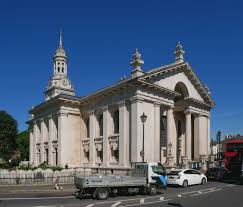 According to tradition, the church was built on the site of the martyrdom, which occurred in 1012, of St Alphege.
According to tradition, the church was built on the site of the martyrdom, which occurred in 1012, of St Alphege.The Archbishop of Canterbury was killed by Vikings.
It was then rebuilt by Hawksmoor in 1714, and yet again after World War II, as a firebomb had fallen on the roof, causing it to collapse.
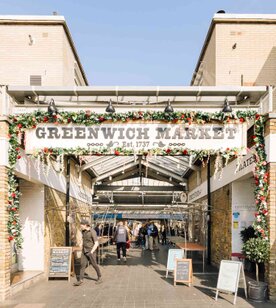 GREENWICH CHARTER MARKET
GREENWICH CHARTER MARKETKING WILLIAM,
TRAIN: GREENWICH
Greenwich's covered market is a colourful and lively place.
On Wednesdays, Fridays, and Saturdays, there are stalls selling crafts; on Thursdays, there are stalls selling antiques and collectables.
Above the entrance, there is a curious inscription:
"A false balance is abomination to the Lord, but a just weight is His delight."
GREENWICH PARK
ROMNEY ROAD
TRAIN: MAZE HILL
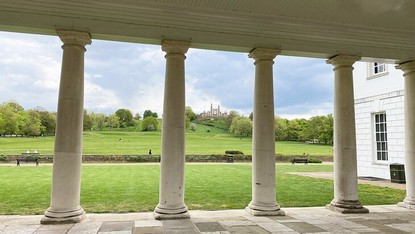
In Greenwich, parks occupy a great deal of space and the most notable of all is Greenwich Park. Its terracing was carried out by Le Nôtre. In it are the remains of Queen Elizabeth's Oak, the oak tree that dates back to the times of Henry VIII and Anne Boleyn.
The remains of the tree are protected by a gate and are marked by a plaque. Next to them, a new young tree has already been planted. The old oak, or at least what remains of it, is in good company, as there is also another at least eight hundred years old in Richmond Park, while in Totteridge Park there is a yew tree which is centuries old. The holm oak in Fulham Palace Park is a youngster in comparison, only five hundred years old. Other venerable trees include the ash tree in the Old St Pancras Cemetery, the fig tree on Amwell Street, the elm tree on Marylebone High Street, the catalpa tree in front of St James's Church in Piccadilly, and the plane tree in Berkeley Square.
The Princess's Pond - In the southern part of Greenwich Park, on Charlton Way, lies a pond that was once used by Princess Caroline of Brunswick. The noblewoman, who had married the Prince Regent, the future King George IV, lived at Montague House in Greenwich. The residence has been demolished, but between the forest ranger's lodge and the rose garden, there is a pond with a stone staircase. It was uncovered in 1909 and the small plaque next to it tells the story and commemorates the princess.
GREENWICH MILLENNIUM VILLAGE
GREENWICH PENINSULA
TUBE: NORTH GREENWICH
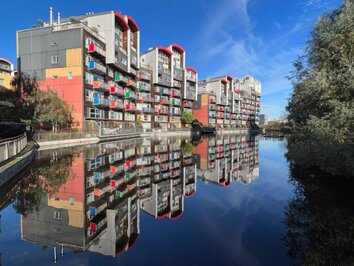 Once upon a time, the Greenwich Peninsula was home to Bugsby's Marshes and Europe's largest gasworks. Today, on those three hundred acres, colourful square and rectangular apartment blocks, designed by Ralph Erskine, stand tall. These modern and innovative housing modules are brought to life by vibrant balconies. The site, which was formerly one of the capital's many industrial areas, has been reclaimed and designated for redevelopment. It sits adjacent to the Ecology Park, the Yacht Club, and Peartree Wharf.
Once upon a time, the Greenwich Peninsula was home to Bugsby's Marshes and Europe's largest gasworks. Today, on those three hundred acres, colourful square and rectangular apartment blocks, designed by Ralph Erskine, stand tall. These modern and innovative housing modules are brought to life by vibrant balconies. The site, which was formerly one of the capital's many industrial areas, has been reclaimed and designated for redevelopment. It sits adjacent to the Ecology Park, the Yacht Club, and Peartree Wharf.The Millennium Village development is supervised by a consortium committed to using environmentally friendly materials, minimising environmental impact, and keeping energy consumption low through renewable energy technologies.
THE HAWKSMOOR WATER CONDUIT
66 CROOM'S HILL
TRAIN: MAZE HILL
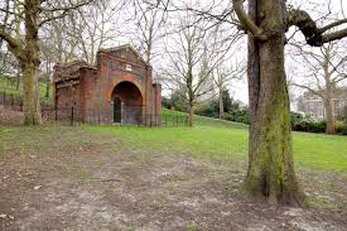 The subsoil of Greenwich Park is riddled with underground passages, conduits and tunnels. It is known that there are at least three brick-lined subterranean tunnels built to channel water from the top of the hill to the Royal Hospital for Seamen, now the National Maritime Museum.
The subsoil of Greenwich Park is riddled with underground passages, conduits and tunnels. It is known that there are at least three brick-lined subterranean tunnels built to channel water from the top of the hill to the Royal Hospital for Seamen, now the National Maritime Museum.To the southwest of the park's eastern edge, between it and Blackheath atop Hyde Vale, stands a beautiful semi-domed brick building. It is a main water conduit, marking the entrance to an underground water pipe that once brought water to the base of the hill. Constructed in the early 18th century, it was restored in 2002 by the Freshwater Group. In the park's western part, semi-hidden by the tree canopy, lies the entrance to the Hawksmoor Conduit. Although architect Hawksmoor was the local overseer of public works and managed the reconstruction and refurbishment of many conduits in the area, it is uncertain whether this is his work. The building, featuring a panel inscribed with "Greenwich Hospital Standard Reservoir", boasts a classical style. Dark and red bricks form a decorative pattern, the tiled ceiling with white profiles takes a trapezoidal shape, and the entrance door, which was only closed by a gate before 1970, is now walled up. The tunnel, still in good condition, is tall enough for a man to stand upright.
ROYAL NAVAL COLLEGE
2 CUTTY SARK GARDENS
TRAIN: GREENWICH
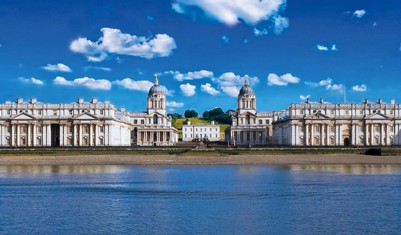 This 18th-century building, initially a hospital for sailors, was designed by Wren and his pupil Hawksmoor. Comprising two symmetrical parts, the interior of the dining hall is adorned with allegorical and heroic frescoes by Thornhill, who was paid by the square metre – one pound for the walls and three pounds for the ceiling. On the latter, Thornhill painted the Triumph of Peace and Liberty, the signs of the zodiac, and the seasons.
This 18th-century building, initially a hospital for sailors, was designed by Wren and his pupil Hawksmoor. Comprising two symmetrical parts, the interior of the dining hall is adorned with allegorical and heroic frescoes by Thornhill, who was paid by the square metre – one pound for the walls and three pounds for the ceiling. On the latter, Thornhill painted the Triumph of Peace and Liberty, the signs of the zodiac, and the seasons.As a model for the winter, he used a ninety-year-old pensioner, often drunk and annoying. In the south-east corner, there is the portrait of Flamsteed, the first royal astronomer, with the telescope used by Newton. In the painting, Flamsteed holds a sheet that predicts the solar eclipse of April 22, 1715. The neo-Greek chapel has a blue vaulted ceiling, and on the altar we see depicted the shipwreck of St. Paul. The paintings in the middle of the gallery windows were carried out by Biagio Rebecca. On the marble floor is portrayed a sailor's compass, with the emblem of the Navy - an encrusted anchor - marking the north.
In King William Walk, you can also find the entrance to the Royal Naval College, marked by enormous globes on the pillars, each with a diameter of one and a half metres. These metal strips once symbolised terrestrial and celestial movements and were installed here in 1834 to commemorate Admiral George Anson's 1740 round-the-world voyage, during which he also relieved a Spanish galleon of half a million pounds to recoup his expenses. King William Walk also serves as the western boundary of the Royal Naval College. Beyond it lies the old city, with its meandering streets, charming shops in Turpin Lane, vibrantly painted facades on Stockwell Street, and the market, established in 1831 by Joseph Kay.
NATIONAL MARITIME MUSEUM
PARK ROW
TRAIN: MAZE HILL
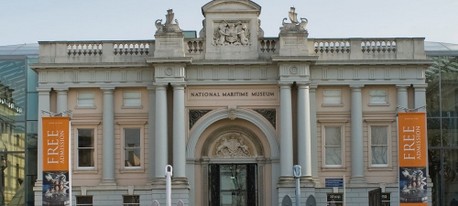 In recent years, the building has been meticulously restored to its original grandeur, closely resembling Inigo Jones' original vision. The south-facing rooms display materials related to the development of the English Navy during James II's reign, including portraits of admirals and, in the Middle Bridge Room, ship models from the latter half of the seventeenth century that influenced later designs. The east room houses the Barberini collection of early astronomical instruments, while the west room contains what was once Willem van de Velde's studio. The two main buildings at the ends of the colonnades focus on the nineteenth and twentieth centuries, particularly migration to the United States and Canada. Exhibits also feature small boats used for transporting goods along Great Britain's coasts and elements from the Thames' shipyards. The Arctic Gallery documents efforts to discover the Northwest Passage. In the Maritime Museum's northeastern section, an array of ancient anchors is displayed, accompanied by a plaque indicating their origins. One of these hails from the Battle of Trafalgar in 1805.
In recent years, the building has been meticulously restored to its original grandeur, closely resembling Inigo Jones' original vision. The south-facing rooms display materials related to the development of the English Navy during James II's reign, including portraits of admirals and, in the Middle Bridge Room, ship models from the latter half of the seventeenth century that influenced later designs. The east room houses the Barberini collection of early astronomical instruments, while the west room contains what was once Willem van de Velde's studio. The two main buildings at the ends of the colonnades focus on the nineteenth and twentieth centuries, particularly migration to the United States and Canada. Exhibits also feature small boats used for transporting goods along Great Britain's coasts and elements from the Thames' shipyards. The Arctic Gallery documents efforts to discover the Northwest Passage. In the Maritime Museum's northeastern section, an array of ancient anchors is displayed, accompanied by a plaque indicating their origins. One of these hails from the Battle of Trafalgar in 1805.FLAMSTEED HOUSE
GREENWICH PARK
TRAIN: NORTH GREENWICH
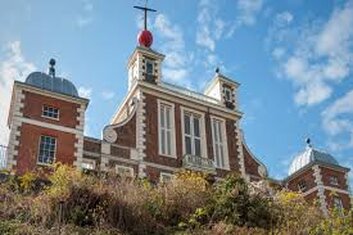 Constructed by Wren, the building has seen numerous subsequent additions. As the first observatory, it features a distinctive roof. The Octagon Room and surrounding galleries showcase a wealth of astronomical instruments, maps, charts, and models. The Halley Gallery's astrolabe collection is among the most significant globally. The Greenwich Meridian passes through the Airy Transit Circle Room and across the courtyard, allowing visitors to stand with one foot in each hemisphere.
Constructed by Wren, the building has seen numerous subsequent additions. As the first observatory, it features a distinctive roof. The Octagon Room and surrounding galleries showcase a wealth of astronomical instruments, maps, charts, and models. The Halley Gallery's astrolabe collection is among the most significant globally. The Greenwich Meridian passes through the Airy Transit Circle Room and across the courtyard, allowing visitors to stand with one foot in each hemisphere.In 1833, on the eastern tower, officials from the Admiralty positioned a time ball which every day, at exactly 1 pm, drops down a thin iron rod. The building to the south became the Planetarium.
The Royal Observatory is located on Blackheath Avenue in Greenwich Park. It was opened in 1675 by Charles II, who wanted ship owners and sailors to benefit from all the help that the sky could possibly provide in order to make navigation safer.
We recommend attending those evenings known as Evenings with the stars, which includes sky observation for enthusiasts. You can also visit the dome at the top of the Victorian tower, designed by Howard Grubb. There is also a beautiful night view of Canary Wharf and the London Eye.
FAN MUSEUM
12 CROOM'S HILL
TRAIN: GREENWICH
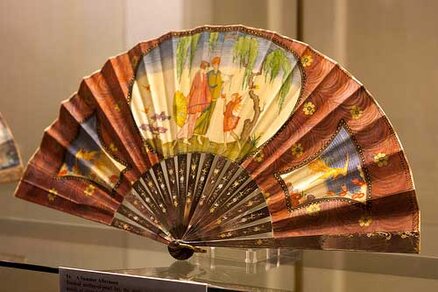 Croom's Hill is a beautiful street that runs at the foot of the hill and borders Greenwich Park to the west. In this street, you will find the curious Fan Museum, housed in two beautiful 18th-century buildings. The collection includes more than 3,500 fans from many countries. Most are from the 18th and 19th centuries, when fans were very popular among all social classes. Many are true works of art, with highly sophisticated decorations, such as those painted by Walter Sickert. Some of the subjects are inspired by history, such as those dedicated to Nelson's victories. Others are advertising vehicles, with colourful images.
Croom's Hill is a beautiful street that runs at the foot of the hill and borders Greenwich Park to the west. In this street, you will find the curious Fan Museum, housed in two beautiful 18th-century buildings. The collection includes more than 3,500 fans from many countries. Most are from the 18th and 19th centuries, when fans were very popular among all social classes. Many are true works of art, with highly sophisticated decorations, such as those painted by Walter Sickert. Some of the subjects are inspired by history, such as those dedicated to Nelson's victories. Others are advertising vehicles, with colourful images.A sign explains their code, where different positions correspond to specific meanings. The museum's inner courtyard serves as both an orangery and a hidden Japanese garden, with tea being served from Tuesday to Sunday.
At number 68 on the same street stands the Church of Our Lady Star of the Sea for sailors. The original building dates back to 1793, primarily serving Irish and Portuguese Catholic sailors. In 1851, it was rebuilt by W. Wardell, with some of the interior decorations by Pugin. The church also features beautiful Art Nouveau stained-glass windows. Along the same street is the Greenwich Theatre, which reopened in 1969. Redesigned by Brian Mecking, it was modernised from a Victorian music hall. The theatre hosts excellent shows, and the upper floor serves as an exhibition gallery for local artists.
At number 19 St German's Place, the street that runs along the park's west side, you can find the magnificent Morden College. Established in 1695 by John Morden as a refuge for "poor, honest, sober, and discreet merchants who have lost their homes as a result of shipwreck or other causes", the palace is built around a quadrangle and may have been designed by Wren. It is an outstanding example of seventeenth-century residential architecture.
RANGER'S HOUSE
CHESTERFIELD WALK
TRAIN: BLACKHEATH
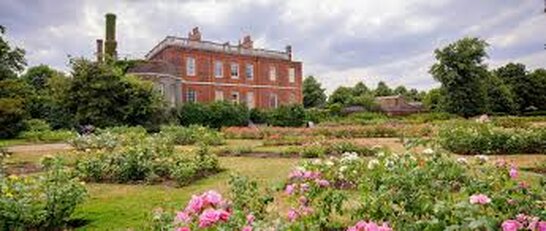 This elegant Georgian villa was constructed in 1680 by Andrew Snape, the king's farrier. In the early nineteenth century, it served as an aristocratic and royal residence, even hosting Princess Sophia Matilda, George III's niece. Later, it became the official residence of the Rangers of Greenwich Park, the park's protectors.
This elegant Georgian villa was constructed in 1680 by Andrew Snape, the king's farrier. In the early nineteenth century, it served as an aristocratic and royal residence, even hosting Princess Sophia Matilda, George III's niece. Later, it became the official residence of the Rangers of Greenwich Park, the park's protectors.Since 1974, the house has been an art gallery, exhibiting the Wernher Collection of medieval and Renaissance works, assembled in the late nineteenth century by jeweller and diamond magnate Julius Wernher. Wernher arrived in South Africa in 1871 and settled in Kimberley, beginning work for a diamond trading company. The panels in the stunning rooms showcase the silvers, jewels, paintings, and porcelains on display, creating a dazzling spectacle. The original atmosphere has been carefully preserved, reflecting the eccentricities of a man who seemed to have stepped out of Kipling's pages. The exhibition also includes early religious paintings and Dutch Old Masters' works. Ivory miniatures demonstrate the genius of medieval artisans and the quality of Renaissance decorative art. The magnificent Suffolk collection of family portraits is also showcased.
Behind the house, there are rose bushes, while in front, a fragrant avenue of lime trees stands, planted in 1977 to celebrate Queen Elizabeth's Silver Jubilee. The meridian line passes through the garden.PARAGON
BLACKHEATH VILLAGE
TRAIN: BLACKHEATH
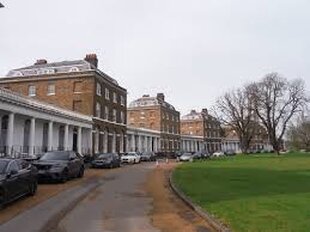 Architecture enthusiasts should visit this late 18th-century complex designed by Michael Searles. It consists of a row of houses arranged in a semicircle, composed of seven pairs of four-storey buildings with mansard roofs, Coade stone decorations on the facade, and interconnected colonnades. Today, they have been converted into apartments.
Architecture enthusiasts should visit this late 18th-century complex designed by Michael Searles. It consists of a row of houses arranged in a semicircle, composed of seven pairs of four-storey buildings with mansard roofs, Coade stone decorations on the facade, and interconnected colonnades. Today, they have been converted into apartments.Until 1855, Charlton was situated in the county of Kent. From that date, it became part of London. In the 18th century, it was famous for a three-day fair, which writer Daniel Defoe severely criticised, suggesting its suppression due to people indulging in all kinds of debauchery.
The first St Luke's Church in Church Lane was constructed of brick around 1600. One of the stone memorial tablets bears the coat of arms of Edward Wilkinson, who died in 1561. He earned it by serving as head cook for Queen Elizabeth. St Luke's clergy have always encouraged embroidery, and some examples of magnificent embroidered vestments worn during services can be seen.CHARLTON HOUSE
CHARLTON ROAD
TRAIN: CHARLTON
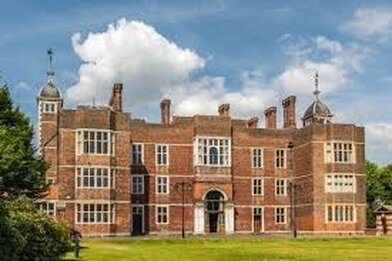 Charlton House was built in 1612 by Adam Newton, tutor to Prince Henry, as a retreat for his old age, possibly designed by Thorpe. The three-storey building is shaped like an H. At the centre of the facade, there is an elaborate porch that leads to a hall, which was one of the first in England to have this right-angled arrangement in relation to the entrance.
Charlton House was built in 1612 by Adam Newton, tutor to Prince Henry, as a retreat for his old age, possibly designed by Thorpe. The three-storey building is shaped like an H. At the centre of the facade, there is an elaborate porch that leads to a hall, which was one of the first in England to have this right-angled arrangement in relation to the entrance.In the large salon on the first floor, there is a magnificent fireplace featuring the figures of Vulcan and Venus in relief. In the White Room, panels depict the Triumph of Christ and the Triumph of Death.
In the garden, a mulberry tree is said to have been planted in 1608. Additionally, a small, charming pavilion, which local tradition attributes to none other than Inigo Jones, has been converted into a toilet. Today, the house is owned by the district and serves as a venue for meetings and exhibitions.
Originally, Woolwich was a small fishing village. In 1513, however, Henry VIII chose it as the ideal location for the royal arsenal. Here, among others, the Great Harry, also known as Henry Grace à Dieu, the flagship of the fleet that the king intended to create, was built in 1514. In 1545, the king was on board when there was a clash with some French ships. He prudently withdrew below deck and escaped unscathed. The neighbouring ship, the Mary Rose, sank. The construction of new vessels continued, and a century later, in 1635, Phineas Pett and his son Peter built the Sovereign of the Seas. Many royals visited here, and many explorers set off from these shores. Over the years, Woolwich has become an important military centre, with a large concentration of buildings related to this world, such as the Arsenal, with its splendid entrance portal and clock. The Royal Arsenal had moved here from Moorfield in 1716. The imposing entrance on Beresford Square, however, was built later, in 1829. Military material warehouses were subsequently added to the Arsenal. The north brick façade is very long and overlooks a parade ground. Today, Woolwich is an important crossing point on the Thames, with a ferry and a tunnel under the river.
WOOLWICH FREE FERRY
TRAIN: NORTH WOOLWICH
WOOLWICH DOCKYARD
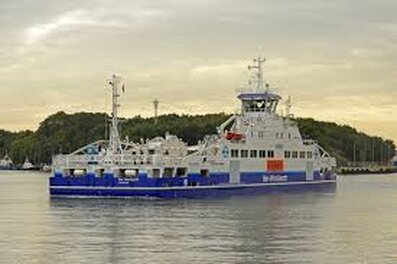 It is certain that there was already a ferry at this point in 1300, but the service probably existed even earlier. The Free Ferry, connecting the north and south banks of Woolwich, has always been an integral part of the city's communication system. The steam ferry began service in 1847 and has been free since 1889. The service operates seven days a week, except at Christmas and New Year, at Gallions Reach, between the Ferry Approach South and Pier Road. Only in the case of thick fog is the service suspended, during which the pedestrian underpass, with its entrance near the terminal, can be used. The tunnel was opened in 1912 by the public administration to allow residents to cross the river, especially when fog prevented the ferry from operating. There are three boats in operation: the Ernest Bevin, the John Burns, and the James Newman. The crossing takes fifteen minutes: five to board passengers and cars, five for the actual journey, and five to disembark.
It is certain that there was already a ferry at this point in 1300, but the service probably existed even earlier. The Free Ferry, connecting the north and south banks of Woolwich, has always been an integral part of the city's communication system. The steam ferry began service in 1847 and has been free since 1889. The service operates seven days a week, except at Christmas and New Year, at Gallions Reach, between the Ferry Approach South and Pier Road. Only in the case of thick fog is the service suspended, during which the pedestrian underpass, with its entrance near the terminal, can be used. The tunnel was opened in 1912 by the public administration to allow residents to cross the river, especially when fog prevented the ferry from operating. There are three boats in operation: the Ernest Bevin, the John Burns, and the James Newman. The crossing takes fifteen minutes: five to board passengers and cars, five for the actual journey, and five to disembark.Each mode of transport carries two hundred passengers and as many vehicles. Just upstream of the ferry, one can occasionally still see ships unloading goods, showing that even though greatly reduced, port activity still exists. On the south bank, in the centre of a paved circle made of porphyry and surrounded by a brick wall, there is a large propeller. Near the opposite terminal, on the other side of the river, in the southeast corner of the Royal Victoria Gardens, there is a steam hammer built in 1888 and used in the forges of the Green & Wier company, which stood next to the Royal Albert Dock, where City Airport is now located.
A MUSEUM IN THE OLD NORTH WOOLWICH STATION
PIER ROAD
TRAIN: PIER ROAD
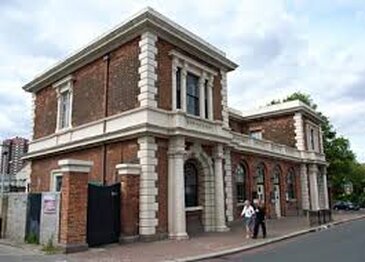 The first station, which opened here in 1847, was a wooden hut in the middle of cultivated land. The 1854 station, on the other hand, became a museum in 1984 because a new one had been opened in North Woolwich in the meantime. One of the locomotives on display was built in 1876 for the Great Eastern Railway. It rests on what was a turntable – anyone who has been to San Francisco has seen one in action – the vehicle was turned by hand for the return journey. There are many posters, among which the one from Felixstowe, dating back to the interwar years and the work of William Robertson Smith Stott, is particularly beautiful. There are truly many memorabilia related to the history of the railway.
The first station, which opened here in 1847, was a wooden hut in the middle of cultivated land. The 1854 station, on the other hand, became a museum in 1984 because a new one had been opened in North Woolwich in the meantime. One of the locomotives on display was built in 1876 for the Great Eastern Railway. It rests on what was a turntable – anyone who has been to San Francisco has seen one in action – the vehicle was turned by hand for the return journey. There are many posters, among which the one from Felixstowe, dating back to the interwar years and the work of William Robertson Smith Stott, is particularly beautiful. There are truly many memorabilia related to the history of the railway.MILLENNIUM MILLS
NORTH WOOLWICH
METRO: PRINCE REGENT
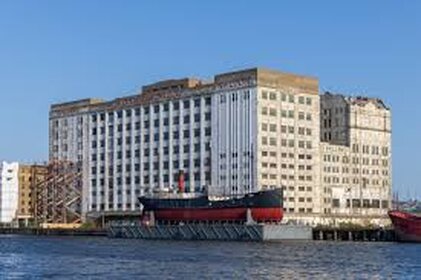 One of the Millennium Mills in Docklands has survived. It was part of the Spillers Millennium Mills, located on the south bank of the Royal Victoria Dock, which had been built for Vernon & Sons. Vernon's mills were then acquired by Spillers. Its name still survives on the façade, although it is now faded. Today, the building has been renovated and houses apartments and conference rooms. In the area, there were also silos for storing and preserving cereals. Along North Woolwich Road, at Pontoon Dock, there is still a grain silo: it is the only cereal silo to have survived. It is a solitary white giant, peeking above the trees and gardens of Pontoon Dock and marked with the letter D, which was used to guide cargo to the right mooring point.
One of the Millennium Mills in Docklands has survived. It was part of the Spillers Millennium Mills, located on the south bank of the Royal Victoria Dock, which had been built for Vernon & Sons. Vernon's mills were then acquired by Spillers. Its name still survives on the façade, although it is now faded. Today, the building has been renovated and houses apartments and conference rooms. In the area, there were also silos for storing and preserving cereals. Along North Woolwich Road, at Pontoon Dock, there is still a grain silo: it is the only cereal silo to have survived. It is a solitary white giant, peeking above the trees and gardens of Pontoon Dock and marked with the letter D, which was used to guide cargo to the right mooring point.THE HISTORY OF ARTILLERY AT THE ROTUNDA
REPOSITORY ROAD
TRAIN: WOOLWICH ARSENAL
 The curious circular building of the museum, located west of the Common, has a roof resembling that of a tent. It began its existence as a tent in St James Park, designed by John Nash in 1814 for the celebrations in honour of the allied sovereigns visiting London. In 1819, it was moved to Woolwich to house objects related to military history. Then, it was decided to make the exhibition permanent, and a polygonal wall with a concave copper ceiling, which looks like fabric, was built. Today, the building houses the Artillery Museum, and inside are exhibits that show its development from 1300 to the present day. There is also a bombard probably used in the Battle of Crécy in 1346 and a brass cannon used at Waterloo.
The curious circular building of the museum, located west of the Common, has a roof resembling that of a tent. It began its existence as a tent in St James Park, designed by John Nash in 1814 for the celebrations in honour of the allied sovereigns visiting London. In 1819, it was moved to Woolwich to house objects related to military history. Then, it was decided to make the exhibition permanent, and a polygonal wall with a concave copper ceiling, which looks like fabric, was built. Today, the building houses the Artillery Museum, and inside are exhibits that show its development from 1300 to the present day. There is also a bombard probably used in the Battle of Crécy in 1346 and a brass cannon used at Waterloo.The exhibits aim to tell the regiment's history from a human perspective, with personal memorabilia on display. There are also drawings by William Congreve and high-quality watercolours. On the north side of Woolwich Common are the Royal Artillery Barracks, built between 1776 and 1802.
ST MARY'S CHURCH
CHURCH STREET
TRAIN: WOOLWICH DOCKYARD
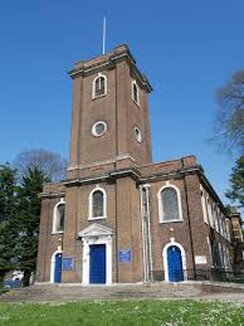 St Mary's Church stands at the top of Church Hill, and its square tower has always served as a landmark in the area. The church is located right at the Woolwich Free Ferry terminal, the free ferry designed to transport people and vehicles across the Thames. The two nearby terracotta temples mark the entrance to the pedestrian tunnel. The church has always had significant naval connections, giving it the right to fly the royal ensign.
St Mary's Church stands at the top of Church Hill, and its square tower has always served as a landmark in the area. The church is located right at the Woolwich Free Ferry terminal, the free ferry designed to transport people and vehicles across the Thames. The two nearby terracotta temples mark the entrance to the pedestrian tunnel. The church has always had significant naval connections, giving it the right to fly the royal ensign.Among the funerary monuments in the cemetery, there is a sad lion looking at an urn. It is a reminder of the great boxer Tom Cribb, who spent his last years in poverty in Woolwich. On the Thames shore, just upstream of the ferry terminal, there is a large anchor with a single palm. Next to it is a small mobile crane, which moved on railway tracks and was used in the docks for lighter loads.
In the distant year of 960, King Edgar had given some acres of land in this area to the Augustinian monks. Today, more than a thousand years later, Plumstead is a multicultural area, predominantly inhabited by people of Asian and Afro-Caribbean descent. The area developed greatly at the end of the 19th century, as its proximity to the arsenal attracted many of its workers to live here. Cycling enthusiasts may have seen images of the area on television in 2007, as the Tour de France passed along High Street.
THE PLUMSTEAD MARSHES
TRAIN: PLUMSTEAD
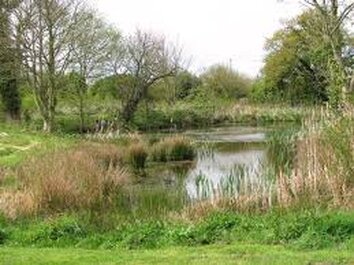 To the east of Woolwich was a vast marshy area, covered in places by stagnant and shallow water, used for centuries by the military as a firing range for exercises. Today, it is being reclaimed and restored. In 1970, the large housing complex known as Thamesmead was built there. Near Creekmouth rises the red Cross Ness lighthouse, marking the northernmost tip of the Plumstead marshes.
To the east of Woolwich was a vast marshy area, covered in places by stagnant and shallow water, used for centuries by the military as a firing range for exercises. Today, it is being reclaimed and restored. In 1970, the large housing complex known as Thamesmead was built there. Near Creekmouth rises the red Cross Ness lighthouse, marking the northernmost tip of the Plumstead marshes.Once, this location was home to just a rocket factory, which exploded in 1864. Since then, the area has been an isolated and deserted place. Today, a few buildings stand here, but wandering through the area evokes a sense of loneliness and desolation.
SEVERNDROOG CASTLE
SHOOTER'S HILL ROAD
TRAIN: ELTHAM
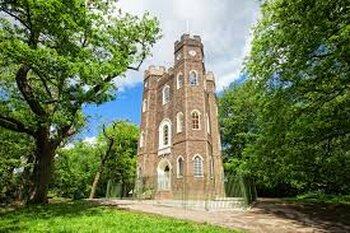 Severndroog Castle is an intriguing name for an equally intriguing structure. Nestled amidst the trees of Castle Wood and located just off Dover Road, this charming and unique folly was built in 1784 as a viewing tower by Lady James of Eltham. Architect Richard Jupp designed the castle to commemorate and celebrate her late husband, William James, who conquered an island off the Malabar coast called Severndroog, a stronghold of Malabar pirates. The castle is surrounded by a picturesque wooded area.
Severndroog Castle is an intriguing name for an equally intriguing structure. Nestled amidst the trees of Castle Wood and located just off Dover Road, this charming and unique folly was built in 1784 as a viewing tower by Lady James of Eltham. Architect Richard Jupp designed the castle to commemorate and celebrate her late husband, William James, who conquered an island off the Malabar coast called Severndroog, a stronghold of Malabar pirates. The castle is surrounded by a picturesque wooded area.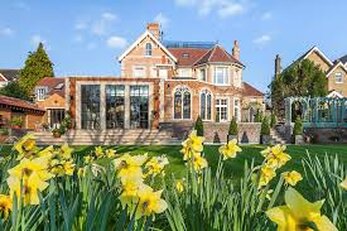 Over the centuries, Eltham developed along the pilgrim route connecting London to Maidstone and leading to the English Channel. This strategic location led to the construction of Eltham Palace. At night, St John the Baptist Church on High Street is particularly evocative, with illuminations enhancing its beauty. In its ancient grassy cemetery, filled with pines and age-old trees, lies the grave of Thomas Dogget, an actor who died in 1721 and initiated the ongoing rowing race. The Quaggy River runs along the southwest boundary, and the lakes of Sutcliffe Park can also be found nearby.
Over the centuries, Eltham developed along the pilgrim route connecting London to Maidstone and leading to the English Channel. This strategic location led to the construction of Eltham Palace. At night, St John the Baptist Church on High Street is particularly evocative, with illuminations enhancing its beauty. In its ancient grassy cemetery, filled with pines and age-old trees, lies the grave of Thomas Dogget, an actor who died in 1721 and initiated the ongoing rowing race. The Quaggy River runs along the southwest boundary, and the lakes of Sutcliffe Park can also be found nearby.ELTHAM PALACE,
52 ELTHAM HIGH STREET
TRAIN: ELTHAM
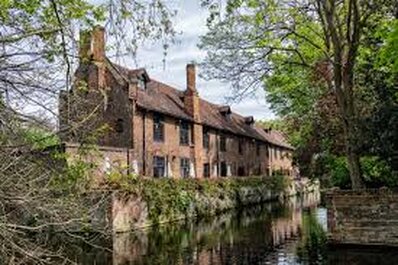 Eltham Palace has a history dating back to the early 1300s. Tradition holds that in 1347, King Edward III founded the Order of the Garter during a meeting held at the palace. Geoffrey Chaucer wrote that while overseeing work for Charles II, he was robbed of twenty pounds while staying at Eltham.
Eltham Palace has a history dating back to the early 1300s. Tradition holds that in 1347, King Edward III founded the Order of the Garter during a meeting held at the palace. Geoffrey Chaucer wrote that while overseeing work for Charles II, he was robbed of twenty pounds while staying at Eltham.Henry VIII expanded the palace and transformed it into a royal residence, with almost a thousand people living there permanently. Recent excavations have unveiled the layout of the buildings from that period. In the centuries that followed, the palace fell into disrepair until 1933, when Samuel Courtauld and his wife, Virginia Peirano, began restoring it in an Art Deco style, which can still be seen today. The vestibule is adorned with frescoes depicting Venice, the walls feature exotic coverings, and the sunken baths on the floor showcase onyx decorations. The Courtaulds also installed a central vacuum cleaning system, synchronised pendulum clocks, and hidden ceiling lights. The ceilings are vaulted, wall sconces are round, and there are portholes and curved motifs throughout. The bedroom resembles a temple, and the boudoir boasts leather wallpaper. The building was significantly damaged by bombings, but in 1995 the royal family restored and opened it to the public. Both the palace and its garden are magnificent to visit.
In Court Road, you'll find Eltham Lodge, a splendid red brick building with white stone decorations. Built in 1663 by Hugh May for banker John Shaw, it is listed as a building of architectural interest. It features a grand staircase and a balustrade carved with acanthus leaf arabesques. It is considered one of the most important houses of its time. To the south, there is a beautiful garden; in the northwest corner of the Tarn, opposite Nottingham station, stands a preserved 1760 ice house that once supplied ice to Eltham Lodge. Today, it serves as the headquarters for a golf club.
THE GREENHOUSE IN AVERY HILL PARK
AVERY HILL ROAD
TRAIN: FALCONWOOD
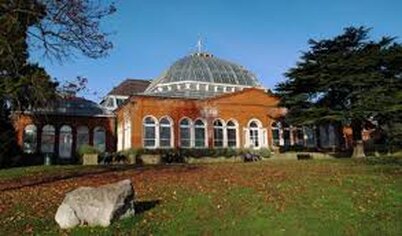 Avery Park is a vast park surrounding what was once a private residence. The building has since been expanded and now belongs to the University of Greenwich. The park, which occupies the former grounds of Colonel North's house, is home to extraordinary trees. The true highlight, however, is the winter garden, one of the most beautiful in England. Sheltered by large windows, tall palms and tropical plants from around the world, some of them potted, thrive in the unique climate conditions. There is also a reconstruction of a desert area, complete with rocks and arid soil. The large glass veranda predates the house and has been restored and enriched with new plants.
Avery Park is a vast park surrounding what was once a private residence. The building has since been expanded and now belongs to the University of Greenwich. The park, which occupies the former grounds of Colonel North's house, is home to extraordinary trees. The true highlight, however, is the winter garden, one of the most beautiful in England. Sheltered by large windows, tall palms and tropical plants from around the world, some of them potted, thrive in the unique climate conditions. There is also a reconstruction of a desert area, complete with rocks and arid soil. The large glass veranda predates the house and has been restored and enriched with new plants.The rose garden is equally stunning. In front of the entrance, there is a fountain featuring a statue of a woman reclining languidly. In another Eltham park, Fairy Hill Park, located in Crossmead, a summer festival takes place with music and dancing. Southwood Park, situated on Southwood Road, is another delightful green space, complete with outdoor gym equipment and a playground for children.
SHOOTER'S HILL WATER TOWER
OLD DOVER ROAD
TRAIN: ELTHAM
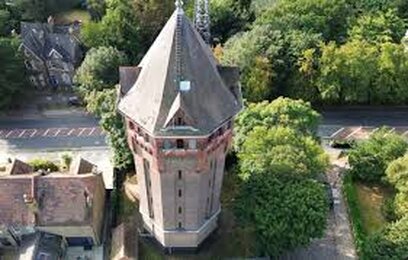 In 1910, a London water company constructed this impressive tower, which houses an elevated water tank. A pump drew water from the nearby Orpington wells up to the tank, and from there, the water flowed by gravity to a pumping station on Well Hall Road. This striking, multicoloured brick octagonal building is situated five hundred metres above sea level. It is an excellent example of a faux-medieval construction, well-executed in its imitation of a castle, complete with a pointed roof – it's just a shame that the mobile phone antennas detract from its authenticity.
In 1910, a London water company constructed this impressive tower, which houses an elevated water tank. A pump drew water from the nearby Orpington wells up to the tank, and from there, the water flowed by gravity to a pumping station on Well Hall Road. This striking, multicoloured brick octagonal building is situated five hundred metres above sea level. It is an excellent example of a faux-medieval construction, well-executed in its imitation of a castle, complete with a pointed roof – it's just a shame that the mobile phone antennas detract from its authenticity.WELL HALL PLEASANCE
WELL HALL ROAD
TRAIN: ELTHAM
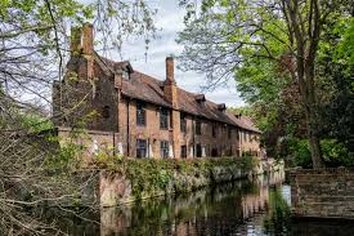 Along the expansive Well Hall Road, which runs through the park, lies a 16th-century building called the Barn, nestled in a picturesque landscape. This historic barn is connected to the Tudor monarchy, who resided in the nearby Eltham Palace. Close to the palace, a house called Well Hall was built, where E. Nesbit lived and described it in her famous children's book, The Wouldbegoods. In 1931, the estate was purchased by the district, and the garden was transformed into a public park boasting a wide variety of plants, with guided tours available if desired. The agricultural shed, featuring a small stained-glass window depicting Margaret Roper – wife of Catholic William and daughter of Thomas More – continues to function as an art gallery and restaurant, offering delightful cream teas, tea-based snacks, sweet scones, jam, and cream. Alternatively, at number 148 of the same street, you can indulge in the French cuisine of Petit Gourmet.
Along the expansive Well Hall Road, which runs through the park, lies a 16th-century building called the Barn, nestled in a picturesque landscape. This historic barn is connected to the Tudor monarchy, who resided in the nearby Eltham Palace. Close to the palace, a house called Well Hall was built, where E. Nesbit lived and described it in her famous children's book, The Wouldbegoods. In 1931, the estate was purchased by the district, and the garden was transformed into a public park boasting a wide variety of plants, with guided tours available if desired. The agricultural shed, featuring a small stained-glass window depicting Margaret Roper – wife of Catholic William and daughter of Thomas More – continues to function as an art gallery and restaurant, offering delightful cream teas, tea-based snacks, sweet scones, jam, and cream. Alternatively, at number 148 of the same street, you can indulge in the French cuisine of Petit Gourmet.
